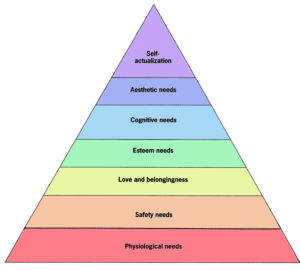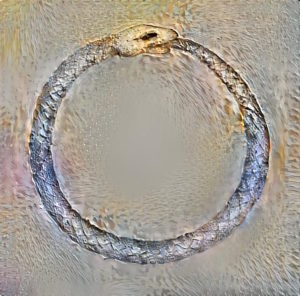
The 7-Chakras provide us with a wonderful road map for how to age gracefully. At birth, we are exclusively focused on meeting the needs of our own personal, immediate survival (first chakra). As we grow older and those needs are met we want more personal autonomy, relationships, love (chakras two, three and four). As we pass middle age, our attention should naturally continue to move up to the higher chakras.
In reference to his pyramid of needs, Maslow grouped the bottom four levels, which correspond closely to the first four chakras as ‘Deficiency Needs’. As these needs are met, motivation declines. Immediately following a large meal, it is less likely you will feel like searching for more food. It is only when these needs (food, shelter, oxygen, water, etc.) are not being met, that we give them much thought. When these needs are being met, we are bored, and when they are not being met we are scared.

Maslow grouped the higher levels of his pyramid, which correspond to the last three chakras, as ‘Growth Needs’. Here, the motivation actually increases as the needs are met. Cognitive needs are a great example of this. The more you know about a subject (like the history of the Civil War, or developmental childhood psychology) the more motivated you are to learn more. With growth needs, we have nothing to lose, and everything to gain.
On the spiritual journey, it is easy to stall when all of your deficiency needs are being met but you have not yet pushed up into the growth needs. Thus, development tends to stagnate during middle age and we easily slip into a life dominated by boredom and/or anxiety. The trick is to deliberately, as an act of will, choose to invest energy in the 5th Chakra. This Chakra is usually associated with self-expression, sometimes with self-control, but I prefer the older association of self-knowledge. The easiest way to do this is meditation. With a little practice, motivation increases. At first slowly and then more rapidly, you begin to feel more motivated to move up into the 5th, 6th and 7th chakras.
At this point, problems arise when we hold on too tightly to the first three chakras. To continue to evolve, we must release our attachment to the lower chakras and redirect that energy to the higher chakras. Starting with the third chakra (power over others and our environment), we should redirect that energy into the 5th chakra, (power over self, or self-knowledge). Instead of trying to control the external universe, we learn how to control our internal reaction to it. Next, we need to release our attachment to the 2nd chakra (external immortality

through procreation) and redirect that energy towards the 6th chakra (internal immortality through spirituality). Finally, at the very end of our spiritual journey, we must release attachment to the first chakra (personal immediate survival), and redirect that energy towards the 7th chakra (self-transcendence). To the degree that we cling to the lower chakras, we are unable to embrace the higher ones.
Perhaps this is what the Ouroboros refers to with the image of the snake, eating its own tail, recycling the lower chakras in service to the higher chakras.
5 Comments
-
Well Said! Thank you for sharing in this way. Love the following:
We need to release our attachment to the 2nd chakra (external immortality
through procreation) and redirect that energy towards the 6th chakra (internal immortality through spirituality). Finally, at the very end of our spiritual journey, we must release attachment to the first chakra (personal immediate survival), and redirect that energy towards the 7th chakra (self-transcendence).and then to the snake image….wow…
-
Interesting perspective on the chakras, Charles! I have never thought or approached them that way. Great food for thought; thank you! Namaste!!!
-
Great article! Thanks for sharing!
-
Thank you!
-
I love this article, never had it explained this way before, thanks!!






